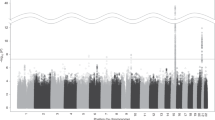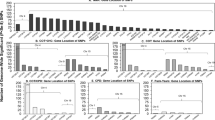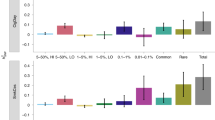Abstract
Our previous linkage study demonstrated that the 9q22–q23 chromosome region showed a ‘suggestive’ linkage to nicotine dependence (ND) in the Framingham Heart Study population. In this study, we provide further evidence for the linkage of this region to ND in an independent sample. Within this region, the gene encoding Src homology 2 domain-containing transforming protein C3 (SHC3) represents a plausible candidate for association with ND, assessed by smoking quantity (SQ), the Heaviness of Smoking Index (HSI) and the Fagerström Test for ND (FTND). We utilized 11 single-nucleotide polymorphisms within SHC3 to examine the association with ND in 602 nuclear families of either African-American (AA) or European-American (EA) origin. Individual SNP-based analysis indicated three SNPs for AAs and one for EAs were significantly associated with at least one ND measure. Haplotype analysis revealed that the haplotypes A-C-T-A-T-A of rs12519–rs3750399–rs4877042–rs2297313–rs1547696–rs1331188, with a frequency of 27.8 and 17.6%, and C-T-A-G-T of rs3750399–rs4877042–rs2297313–rs3818668–rs1547696, at a frequency of 44.7 and 30.6% in the AA and Combined samples, respectively, were significantly inversely associated with the ND measures. In the EA sample, another haplotype with a frequency of 10.6%, A-G-T-G of rs1331188–rs1556384–rs4534195–rs1411836, showed a significant inverse association with ND measures. These associations remained significant after Bonferroni correction. We further demonstrated the SHC3 contributed 40.1–59.2% (depending on the ND measures) of the linkage signals detected on chromosome 9. As further support, we found that nicotine administered through infusion increased the Shc3 mRNA level by 60% in the rat striatum, and decreased it by 22% in the nucleus accumbens (NA). At the protein level, Shc3 was decreased by 38.0% in the NA and showed no change in the striatum. Together, these findings strongly implicate SHC3 in the etiology of ND, which represents an important biological candidate for further investigation.
This is a preview of subscription content, access via your institution
Access options
Subscribe to this journal
Receive 12 print issues and online access
$259.00 per year
only $21.58 per issue
Buy this article
- Purchase on Springer Link
- Instant access to full article PDF
Prices may be subject to local taxes which are calculated during checkout





Similar content being viewed by others
Accession codes
References
Sullivan PF, Kendler KS . The genetic epidemiology of smoking. Nicotine Tob Res 1999; 1 (Suppl 2): S51–S57; discussion S69–S70.
Li MD, Cheng R, Ma JZ, Swan GE . A meta-analysis of estimated genetic and environmental effects on smoking behavior in male and female adult twins. Addiction 2003; 98: 23–31.
Li MD, Ma JZ, Cheng R, Dupont R, Williams KC, Payne TJ et al. A genome-wide scan to identify loci for smoking rate in the Framingham Heart Study populations. BMC Genet 2003; 4 (Suppl I): S103.
Bergen AW, Korczak JF, Weissbecker KA, Goldstein AM . A genome-wide search for loci contributing to smoking and alcoholism. Genet Epidemiol 1999; 17 (Suppl 1): S55–S60.
Bierut LJ, Rice JP, Goate A, Hinrichs AL, Saccone NL, Foroud T et al. A genomic scan for habitual smoking in families of alcoholics: common and specific genetic factors in substance dependence. Am J Med Genet 2004; 124A: 19–27.
Gelernter J, Liu X, Hesselbrock V, Page GP, Goddard A, Zhang H . Results of a genomewide linkage scan: support for chromosomes 9 and 11 loci increasing risk for cigarette smoking. Am J Med Genet 2004; 128B: 94–101.
Beuten J, Ma JZ, Payne TJ, Dupont RT, Crews KM, Somes G et al. Single- and multilocus allelic variants within the GABAB receptor subunit 2 (GABAB2) gene are significantly associated with nicotine dependence. Am J Hum Genet 2005; 76: 859–864.
Beuten J, Ma JZ, Payne TJ, Dupont RT, Lou XY, Crews KM et al. Association of specific haplotyes of neurotropic tyrosine kinase receptor 2 (NTRK2) gene with vulnerability to nicotine dependence in African-Americans and European-Americans. Biol Psychiatry (Advance online publication, 19 May 2006; doi:1016/j.biopsych.2006.02.023).
Yamaguchi F, Yamaguchi K, Tokuda M, Brenner S . Molecular cloning of EDG-3 and N-Shc genes from the puffer fish, Fugu rubripes, and conservation of synteny with the human genome. FEBS Lett 1999; 459: 105–110.
Pelicci G, Lanfrancone L, Grignani F, McGlade J, Cavallo F, Forni G et al. A novel transforming protein (SHC) with an SH2 domain is implicated in mitogenic signal transduction. Cell 1992; 70: 93–104.
Pelicci G, Dente L, De Giuseppe A, Verducci-Galletti B, Giuli S, Mele S et al. A family of Shc related proteins with conserved PTB, CH1 and SH2 regions. Oncogene 1996; 13: 633–641.
O'Bryan JP, Songyang Z, Cantley L, Der CJ, Pawson T . A mammalian adaptor protein with conserved Src homology 2 and phosphotyrosine-binding domains is related to Shc and is specifically expressed in the brain. Proc Natl Acad Sci USA 1996; 93: 2729–2734.
Cattaneo E, Pelicci PG . Emerging roles for SH2/PTB-containing Shc adaptor proteins in the developing mammalian brain. Trends Neurosci 1998; 21: 476–481.
Conti L, Sipione S, Magrassi L, Bonfanti L, Rigamonti D, Pettirossi V et al. Shc signaling in differentiating neural progenitor cells. Nat Neurosci 2001; 4: 579–586.
Nakamura T, Muraoka S, Sanokawa R, Mori N . N-Shc and Sck, two neuronally expressed Shc adapter homologs. Their differential regional expression in the brain and roles in neurotrophin and Src signaling. J Biol Chem 1998; 273: 6960–6967.
Liu HY, Meakin SO . ShcB and ShcC activation by the Trk family of receptor tyrosine kinases. J Biol Chem 2002; 277: 26046–26056.
Nestler EJ . Molecular neurobiology of addiction. Am J Addict 2001; 10: 201–217.
Brunzell DH, Russell DS, Picciotto MR . In vivo nicotine treatment regulates mesocorticolimbic CREB and ERK signaling in C57Bl/6J mice. J Neurochem 2003; 84: 1431–1441.
Thomas GM, Huganir RL . MAPK cascade signalling and synaptic plasticity. Nat Rev Neurosci 2004; 5: 173–183.
Valjent E, Pages C, Herve D, Girault JA, Caboche J . Addictive and non-addictive drugs induce distinct and specific patterns of ERK activation in mouse brain. Eur J Neurosci 2004; 19: 1826–1836.
Miyamoto Y, Chen L, Sato M, Sokabe M, Nabeshima T, Pawson T et al. Hippocampal synaptic modulation by the phosphotyrosine adapter protein ShcC/N-Shc via interaction with the NMDA receptor. J Neurosci 2005; 25: 1826–1835.
Troglio F, Echart C, Gobbi A, Pawson T, Pelicci PG, De Simoni MG et al. The Rai (Shc C) adaptor protein regulates the neuronal stress response and protects against cerebral ischemia. Proc Natl Acad Sci USA 2004; 101: 15476–15481.
Heatherton TF, Kozlowski LT, Frecker RC, Fagerstrom KO . The Fagerstrom test for nicotine dependence: a revision of the Fagerstrom Tolerance Questionnaire. Br J Addict 1991; 86: 1119–1127.
O'Connell JR, Weeks DE . PedCheck: a program for identification of genotype incompatibilities in linkage analysis. Am J Hum Genet 1998; 63: 259–266.
Boehnke M, Cox NJ . Accurate inference of relationships in sib-pair linkage studies. Am J Hum Genet 1997; 61: 423–429.
Shete S, Jacobs KB, Elston RC . Adding further power to the Haseman and Elston method for detecting linkage in larger sibships: weighting sums and differences. Hum Hered 2003; 55: 79–85.
Iyengar SK, Song D, Klein BE, Klein R, Schick JH, Humphrey J et al. Dissection of genomewide-scan data in extended families reveals a major locus and oligogenic susceptibility for age-related macular degeneration. Am J Hum Genet 2004; 74: 20–39.
Barrett JC, Fry B, Maller J, Daly MJ . Haploview: analysis and visualization of LD and haplotype maps. Bioinformatics 2005; 21: 263–265.
Gabriel SB, Schaffner SF, Nguyen H, Moore JM, Roy J, Blumenstiel B et al. The structure of haplotype blocks in the human genome. Science 2002; 296: 2225–2229.
Lange C, Silverman EK, Xu X, Weiss ST, Laird NM . A multivariate family-based association test using generalized estimating equations: FBAT-GEE. Biostatistics 2003; 4: 195–206.
Horvath S, Xu X, Lake SL, Silverman EK, Weiss ST, Laird NM . Family-based tests for associating haplotypes with general phenotype data: application to asthma genetics. Genet Epidemiol 2004; 26: 61–69.
Nyholt DR . A simple correction for multiple testing for single-nucleotide polymorphisms in linkage disequilibrium with each other. Am J Hum Genet 2004; 74: 765–769.
Paxinos G, watson C . The Rat Brain in Stereotaxic Coordinates. Academic Press: Sydney, 1986.
Winer J, Jung CK, Shackel I, Williams PM . Development and validation of real-time quantitative reverse transcriptase-polymerase chain reaction for monitoring gene expression in cardiac myocytes in vitro. Anal Biochem 1999; 270: 41–49.
Nyholt DR . All LODs are not created equal. Am J Hum Genet 2000; 67: 282–288.
Sun D, Huang W, Hwang YY, Zhang Y, Zhang Q, Li MD . Regulation by nicotine of Gpr51 and Ntrk2 expression in various rat brain regions. Neuropharmacology (Advance online publication, 21 June 2006; doi:10.1038/sj.npp.1301134).
Pelicci G, Troglio F, Bodini A, Melillo RM, Pettirossi V, Coda L et al. The neuron-specific Rai (ShcC) adaptor protein inhibits apoptosis by coupling Ret to the phosphatidylinositol 3-kinase/Akt signaling pathway. Mol Cell Biol 2002; 22: 7351–7363.
Wall JD, Pritchard JK . Haplotype blocks and linkage disequilibrium in the human genome. Nat Rev Genet 2003; 4: 587–597.
Perez-Stable EJ, Herrera B, Jacob III P, Benowitz NL . Nicotine metabolism and intake in black and white smokers. JAMA 1998; 280: 152–156.
Benowitz NL, Perez-Stable EJ, Fong I, Modin G, Herrera B, Jacob III P . Ethnic differences in N-glucuronidation of nicotine and cotinine. J Pharmacol Exp Ther 1999; 291: 1196–1203.
Batra V, Patkar AA, Berrettini WH, Weinstein SP, Leone FT . The genetic determinants of smoking. Chest 2003; 123: 1730–1739.
Noble EP . D2 dopamine receptor gene in psychiatric and neurologic disorders and its phenotypes. Am J Med Genet 2003; 116B: 103–125.
Lu L, Hope BT, Dempsey J, Liu SY, Bossert JM, Shaham Y . Central amygdala ERK signaling pathway is critical to incubation of cocaine craving. Nat Neurosci 2005; 8: 212–219.
Tang K, Wu H, Mahata SK, O'Connor DT . A crucial role for the mitogen-activated protein kinase pathway in nicotinic cholinergic signaling to secretory protein transcription in pheochromocytoma cells. Mol Pharmacol 1998; 54: 59–69.
Mazzucchelli C, Vantaggiato C, Ciamei A, Fasano S, Pakhotin P, Krezel W et al. Knockout of ERK1 MAP kinase enhances synaptic plasticity in the striatum and facilitates striatal-mediated learning and memory. Neuron 2002; 34: 807–820.
Sanna PP, Simpson C, Lutjens R, Koob G . ERK regulation in chronic ethanol exposure and withdrawal. Brain Res 2002; 948: 186–191.
Konu O, Kane JK, Barrett T, Vawter MP, Chang R, Ma JZ et al. Region-specific transcriptional response to chronic nicotine in rat brain. Brain Res 2001; 909: 194–203.
Chen J, Sidhu A . The role of D1 dopamine receptors and phospho-ERK in mediating cytotoxicity (Commentary). Neurotox Res 2005; 7: 179–181.
Wang C, Buck DC, Yang R, Macey TA, Neve KA . Dopamine D2 receptor stimulation of mitogen-activated protein kinases mediated by cell type-dependent transactivation of receptor tyrosine kinases. J Neurochem 2005; 93: 899–909.
Breslau N, Peterson EL, Schultz LR, Chilcoat HD, Andreski P . Major depression and stages of smoking. A longitudinal investigation. Arch Gen Psychiatry 1998; 55: 161–166.
Murphy JM, Horton NJ, Monson RR, Laird NM, Sobol AM, Leighton AH . Cigarette smoking in relation to depression: historical trends from the Stirling County Study. Am J Psychiatry 2003; 160: 1663–1669.
Kendler KS, Neale MC, MacLean CJ, Heath AC, Eaves LJ, Kessler RC . Smoking and major depression. A causal analysis. Arch Gen Psychiatry 1993; 50: 36–43.
Dierker LC, Avenevoli S, Stolar M, Merikangas KR . Smoking and depression: an examination of mechanisms of comorbidity. Am J Psychiatry 2002; 159: 947–953.
Acknowledgements
This project is funded by NIH Grants DA-12844 and DA-13783 to MDL. We thank the Center for Inherited Disease Research (CIDR) for performing the MSTF genome scan. Detailed information on laboratory methods and markers can be found at http://www.cidr.jhmi.edu. Some of the results of this paper were obtained using the program S.A.G.E. (v. 5.0), which is supported by a US Public Health Service Resource Grant (RR03655) from the National Center for Research Resources. We also thank the Rutgers University Cell and DNA Repository, the contractor for the NIDA Center for Genetic Studies, co-directed by Dr Jay Tischfield and Dr John Rice.
Author information
Authors and Affiliations
Corresponding author
Rights and permissions
About this article
Cite this article
Li, M., Sun, D., Lou, XY. et al. Linkage and association studies in African- and Caucasian-American populations demonstrate that SHC3 is a novel susceptibility locus for nicotine dependence. Mol Psychiatry 12, 462–473 (2007). https://doi.org/10.1038/sj.mp.4001933
Received:
Revised:
Accepted:
Published:
Issue Date:
DOI: https://doi.org/10.1038/sj.mp.4001933
Keywords
This article is cited by
-
Converging findings from linkage and association analyses on susceptibility genes for smoking and other addictions
Molecular Psychiatry (2016)
-
Significant association of CHRNB3 variants with nicotine dependence in multiple ethnic populations
Molecular Psychiatry (2013)
-
Multi-locus genome-wide association analysis supports the role of glutamatergic synaptic transmission in the etiology of major depressive disorder
Translational Psychiatry (2012)
-
The CHRNA5–A3–B4 gene cluster in nicotine addiction
Molecular Psychiatry (2012)
-
Genetics of GABAergic signaling in nicotine and alcohol dependence
Human Genetics (2012)



